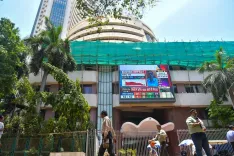Why Did the Indian Stock Market End Sharply Lower?

Synopsis
Key Takeaways
- Indian stock market closed sharply lower on July 25.
- Sensex and Nifty both experienced significant declines.
- Heavy selling pressure affected multiple sectors.
- Market sentiment turned bearish with caution advised for investors.
- Focus shifting to US Federal Reserve's interest rate decision.
Mumbai, July 25 (NationPress) The Indian stock market experienced a significant downturn on Friday, with domestic stock indices retreating by up to one percent amid intense selling pressure.
The Sensex concluded at 81,463.09, dropping 721.08 points or 0.88 percent. The 30-share index commenced trading on a negative note at 82,066.76, compared to the previous session's close of 82,184.17. Despite the UK-India FTA announcement, the market did not rally; rather, the index plummeted over 950 points, reaching an intraday low of 81,397.69.
The Nifty index settled at 24,837.0, down 225.10 points or 0.90 percent.
According to Ashika Institutional Equities, "The overall market sentiment remained bearish, with notable weakness across sectors such as Media, Energy, Oil & Gas, PSU Bank, Auto, and IT."
The prevailing market tone was distinctly risk-off, intensified by sectoral challenges and the breach of crucial index support levels, indicating that caution may dominate in the near future, the note added.
Leading the losses among the Sensex constituents were Bajaj Finance, Tech Mahindra, Bajaj FinServ, Infosys, Trent, Tata Motors, NTPC, Maruti Suzuki, SBI, Tata Steel, and HCL Tech. Conversely, Sun Pharma and Bharti Airtel managed to stay in the positive.
In the Nifty50, 43 stocks declined while only 7 advanced.
The selling pressure extended beyond heavyweights, affecting the broader market significantly.
The Nifty 100 fell 259 points or 1 percent, the Nifty Midcap 100 decreased by 951 points or 1.61 percent, and the Nifty Smallcap 100 closed down 392.35 points or 2.10 percent.
Sector-wise, Nifty Bank plunged 537 points or 0.94 percent, Nifty Fin Service dropped 238 points or 0.88 percent, Nifty Auto dipped 305 points or 1.27 percent, and Nifty IT concluded the session down 305 points or 1.27 percent.
The rupee remained under pressure, trading below 86.50 with a 0.13 percent decline against the dollar, which traded higher around 97.68. The strengthening dollar and profit-booking in capital markets negatively impacted the rupee.
Jateen Trivedi from LKP Securities mentioned, "Market attention now turns to next week’s US Federal Reserve interest rate decision, with mixed expectations amid governmental pressure for a rate cut. In the near term, the rupee is likely to fluctuate within a range of 86.00–87.00."









